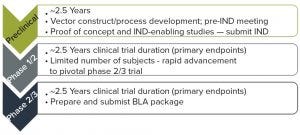- Sponsored Content
- Gene Therapies
- Emerging Therapeutics
AAV Vector Manufacturing Platform Selection and Product DevelopmentAAV Vector Manufacturing Platform Selection and Product Development
Sponsored by Latham BioPharm Group

Figure 1: Ideal AAV gene therapy development timeline
Adenoassociated virus (AAV) vectors have emerged as the prominent delivery mechanisms of corrective gene therapies. Three such products — Glybera (alipogene tiparvovec, uniQure), Luxturna (voretigene neparvovec-rzyl, Spark Therapeutics), and Zolgensma (onasemnogene abeparvovec-xioi, AveXis) — have been licensed, and a growing number of candidates are entering late-stage development. In mapping out an AAV gene therapy product development strategy, biomanufacturers should address fundamental considerations for their manufacturing strategies for both phase 1–2 clinical evaluation and translation for commercial market supply. A manufacturing strategy encompasses a supply chain of critical raw materials, a cell-substrate manufacturing platform, and a decision either to outsource manufacturing to contract development and manufacturing organizations (CDMOs) or to establish internal manufacturing capabilities. Herein we provide a snapshot of some key options and variables and their potential impacts on AAV vector manufacturing.
Fill out the form below to read the full article now.
References
1 Draft Guidance for Industry: Chemistry, Manufacturing, and Control (CMC) for Human Gene Therapy Investigational New Drug Applications (INDs). US Food and Drug Administration: Rockville, MD, 2018.
2 Clément N, Grieger JC. Manufacturing of Recombinant Adeno-Associated Viral Vectors for Clinical Trials. Mol. Ther. Methods Clin. Dev. 16 March 2016; doi:10.1038/mtm.2016.2.
3 Allay JA, et al. Good Manufacturing Practice Production of Self-Complementary Serotype 8 Adeno-Associated Viral Vector for a Hemophilia B Clinical Trial. Hum. Gene Ther. 22(5) 2011: 595–604.
4 Urabe M, Ding C, Kotin RM. Insect Cells As a Factory to Produce Adeno-Associated Virus Type 2 Vectors. Hum. Gene Ther. 13(16) 2002: 1935–1943.
5 Lennaertz A, et al. Viral Vector Production in the Integrity® iCELLis® Single-Use Fixed-Bed Bioreactor, from Bench-Scale to Industrial Scale. BMC Proc. 7(suppl 6) 2013: 59.
6 Yuan Z, et al. A Versatile Adeno-Associated Virus Vector Producer Cell Line Method for Scalable Vector Production of Different Serotypes. Hum. Gene Ther. 22(5) 2011: 613–624.
7 Mietzsch M, et al. OneBac 2.0: Sf9 Cell Lines for Production of AAV1, AAV2, and AAV8 Vectors with Minimal Encapsidation of Foreign DNA. Hum. Gene Ther. Methods 28(1) 2017: 15–22; doi:10.1089/hgtb.2016.164.
8 Kotin RM, Snyder RO. Manufacturing Clinical Grade Recombinant Adeno-Associated Virus Using Invertebrate Cell Lines. Hum. Gene Ther. 28(4) 2017: 350–360; doi:10.1089/hum.2017.042.
9 Gaudet D, et al. Efficacy and Long-Term Safety of Alipogene Tiparvovec (AAV1-LPL S447X) Gene Therapy for Lipoprotein Lipase Deficiency: An Open-Label Trial. Gene Ther. 20(4) 2013: 361–369; doi:10.1038/gt.2012.43 2013.
Corresponding author Joseph Rininger ([email protected]) is director of cell and gene therapy, Ashley Fennell is associate consultant, Lauren Schoukroun-Barnes is senior associate consultant, and Joshua Speidel is managing director, all at Latham Biopharm Group, 101 Main Street, Suite 1400, Cambridge, MA 02142.
You May Also Like






